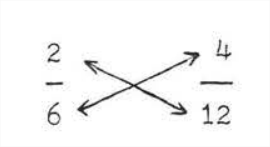4.1: Proportions
- Page ID
- 34135
\( \newcommand{\vecs}[1]{\overset { \scriptstyle \rightharpoonup} {\mathbf{#1}} } \)
\( \newcommand{\vecd}[1]{\overset{-\!-\!\rightharpoonup}{\vphantom{a}\smash {#1}}} \)
\( \newcommand{\dsum}{\displaystyle\sum\limits} \)
\( \newcommand{\dint}{\displaystyle\int\limits} \)
\( \newcommand{\dlim}{\displaystyle\lim\limits} \)
\( \newcommand{\id}{\mathrm{id}}\) \( \newcommand{\Span}{\mathrm{span}}\)
( \newcommand{\kernel}{\mathrm{null}\,}\) \( \newcommand{\range}{\mathrm{range}\,}\)
\( \newcommand{\RealPart}{\mathrm{Re}}\) \( \newcommand{\ImaginaryPart}{\mathrm{Im}}\)
\( \newcommand{\Argument}{\mathrm{Arg}}\) \( \newcommand{\norm}[1]{\| #1 \|}\)
\( \newcommand{\inner}[2]{\langle #1, #2 \rangle}\)
\( \newcommand{\Span}{\mathrm{span}}\)
\( \newcommand{\id}{\mathrm{id}}\)
\( \newcommand{\Span}{\mathrm{span}}\)
\( \newcommand{\kernel}{\mathrm{null}\,}\)
\( \newcommand{\range}{\mathrm{range}\,}\)
\( \newcommand{\RealPart}{\mathrm{Re}}\)
\( \newcommand{\ImaginaryPart}{\mathrm{Im}}\)
\( \newcommand{\Argument}{\mathrm{Arg}}\)
\( \newcommand{\norm}[1]{\| #1 \|}\)
\( \newcommand{\inner}[2]{\langle #1, #2 \rangle}\)
\( \newcommand{\Span}{\mathrm{span}}\) \( \newcommand{\AA}{\unicode[.8,0]{x212B}}\)
\( \newcommand{\vectorA}[1]{\vec{#1}} % arrow\)
\( \newcommand{\vectorAt}[1]{\vec{\text{#1}}} % arrow\)
\( \newcommand{\vectorB}[1]{\overset { \scriptstyle \rightharpoonup} {\mathbf{#1}} } \)
\( \newcommand{\vectorC}[1]{\textbf{#1}} \)
\( \newcommand{\vectorD}[1]{\overrightarrow{#1}} \)
\( \newcommand{\vectorDt}[1]{\overrightarrow{\text{#1}}} \)
\( \newcommand{\vectE}[1]{\overset{-\!-\!\rightharpoonup}{\vphantom{a}\smash{\mathbf {#1}}}} \)
\( \newcommand{\vecs}[1]{\overset { \scriptstyle \rightharpoonup} {\mathbf{#1}} } \)
\( \newcommand{\vecd}[1]{\overset{-\!-\!\rightharpoonup}{\vphantom{a}\smash {#1}}} \)
\(\newcommand{\avec}{\mathbf a}\) \(\newcommand{\bvec}{\mathbf b}\) \(\newcommand{\cvec}{\mathbf c}\) \(\newcommand{\dvec}{\mathbf d}\) \(\newcommand{\dtil}{\widetilde{\mathbf d}}\) \(\newcommand{\evec}{\mathbf e}\) \(\newcommand{\fvec}{\mathbf f}\) \(\newcommand{\nvec}{\mathbf n}\) \(\newcommand{\pvec}{\mathbf p}\) \(\newcommand{\qvec}{\mathbf q}\) \(\newcommand{\svec}{\mathbf s}\) \(\newcommand{\tvec}{\mathbf t}\) \(\newcommand{\uvec}{\mathbf u}\) \(\newcommand{\vvec}{\mathbf v}\) \(\newcommand{\wvec}{\mathbf w}\) \(\newcommand{\xvec}{\mathbf x}\) \(\newcommand{\yvec}{\mathbf y}\) \(\newcommand{\zvec}{\mathbf z}\) \(\newcommand{\rvec}{\mathbf r}\) \(\newcommand{\mvec}{\mathbf m}\) \(\newcommand{\zerovec}{\mathbf 0}\) \(\newcommand{\onevec}{\mathbf 1}\) \(\newcommand{\real}{\mathbb R}\) \(\newcommand{\twovec}[2]{\left[\begin{array}{r}#1 \\ #2 \end{array}\right]}\) \(\newcommand{\ctwovec}[2]{\left[\begin{array}{c}#1 \\ #2 \end{array}\right]}\) \(\newcommand{\threevec}[3]{\left[\begin{array}{r}#1 \\ #2 \\ #3 \end{array}\right]}\) \(\newcommand{\cthreevec}[3]{\left[\begin{array}{c}#1 \\ #2 \\ #3 \end{array}\right]}\) \(\newcommand{\fourvec}[4]{\left[\begin{array}{r}#1 \\ #2 \\ #3 \\ #4 \end{array}\right]}\) \(\newcommand{\cfourvec}[4]{\left[\begin{array}{c}#1 \\ #2 \\ #3 \\ #4 \end{array}\right]}\) \(\newcommand{\fivevec}[5]{\left[\begin{array}{r}#1 \\ #2 \\ #3 \\ #4 \\ #5 \\ \end{array}\right]}\) \(\newcommand{\cfivevec}[5]{\left[\begin{array}{c}#1 \\ #2 \\ #3 \\ #4 \\ #5 \\ \end{array}\right]}\) \(\newcommand{\mattwo}[4]{\left[\begin{array}{rr}#1 \amp #2 \\ #3 \amp #4 \\ \end{array}\right]}\) \(\newcommand{\laspan}[1]{\text{Span}\{#1\}}\) \(\newcommand{\bcal}{\cal B}\) \(\newcommand{\ccal}{\cal C}\) \(\newcommand{\scal}{\cal S}\) \(\newcommand{\wcal}{\cal W}\) \(\newcommand{\ecal}{\cal E}\) \(\newcommand{\coords}[2]{\left\{#1\right\}_{#2}}\) \(\newcommand{\gray}[1]{\color{gray}{#1}}\) \(\newcommand{\lgray}[1]{\color{lightgray}{#1}}\) \(\newcommand{\rank}{\operatorname{rank}}\) \(\newcommand{\row}{\text{Row}}\) \(\newcommand{\col}{\text{Col}}\) \(\renewcommand{\row}{\text{Row}}\) \(\newcommand{\nul}{\text{Nul}}\) \(\newcommand{\var}{\text{Var}}\) \(\newcommand{\corr}{\text{corr}}\) \(\newcommand{\len}[1]{\left|#1\right|}\) \(\newcommand{\bbar}{\overline{\bvec}}\) \(\newcommand{\bhat}{\widehat{\bvec}}\) \(\newcommand{\bperp}{\bvec^\perp}\) \(\newcommand{\xhat}{\widehat{\xvec}}\) \(\newcommand{\vhat}{\widehat{\vvec}}\) \(\newcommand{\uhat}{\widehat{\uvec}}\) \(\newcommand{\what}{\widehat{\wvec}}\) \(\newcommand{\Sighat}{\widehat{\Sigma}}\) \(\newcommand{\lt}{<}\) \(\newcommand{\gt}{>}\) \(\newcommand{\amp}{&}\) \(\definecolor{fillinmathshade}{gray}{0.9}\)In our discussion of similar triangles the idea of a proportion will play an important role. In this section we will review the important properties of proportions.
A proportion is an equation which states that two fractions are equal. For example, \(\dfrac{2}{6}=\dfrac{4}{12}\) is a proportion. We sometimes say "2 is to 6 as 4 is to \(12\)." This is also written \(2: 6 = 4:12\). The extremes of this proportion are the numbers 2 and 12 and the means are the numbers 6 and 4. Notice that the product of the means \(6 \times 4=24\) is the same as the product of the extremes \(2 \times 12=24\).
If \(\dfrac{a}{b} = \dfrac{c}{d}\) then \(a d= be\). Conversely, if \(ad = bc\) then \(\dfrac{a}{b} = \dfrac{c}{d}.\) (The product of the means is equal to the product of the extremes).
EXAMPLES:
- \(\dfrac{2}{6} = \dfrac{4}{12}\) and \(2 \times 12=6 \times 4\) are both true.
- \(\dfrac{2}{3} = \dfrac{6}{9}\) and \(2 \times 9=3 \times 6\) are both true.
- \(\dfrac{1}{4} = \dfrac{4}{12}\) and \(1 \times 12=4 \times 4\) are both false.
Proof of Theorem 1: If \(\dfrac{a}{b} = \dfrac{c}{d}\), multiply both sides of the equation by \(bd\):
\[\dfrac{a}{\cancel{b}} (\cancel{b} d) = \dfrac{c}{\cancel{d}} (b \cancel{d})\]
We obtain \(ad = bc\).
Conversely, if \(ad = bc\), divide both sides of the equation by \(bd\):
\[\dfrac{d\cancel{d}}{b\cancel{d}} = \dfrac{\cancel{b}c}{\cancel{b}d}\]
The result is \(\dfrac{a}{b} = \dfrac{c}{d}\).
The following theorem shows that we can interchange the means or the extremes or both of them simultaneously and still have a valid proportion:
If one of the following is true then they are all true:
- \(\dfrac{a}{b}=\dfrac{c}{d}\)
- \(\dfrac{a}{c}=\dfrac{b}{d}\)
- \(\dfrac{d}{b}=\dfrac{c}{a}\)
- \(\dfrac{d}{c}=\dfrac{b}{a}\)
- Proof
-
If any one of these proportions is true when \(ad = bc\) by Theorem \(\PageIndex{1}\). The remaining proportions can then be obtained from \(ad = bc\) by division, as in Theorem \(\PageIndex{1}\).
EXAMPLE: \(\dfrac{2}{6} = \dfrac{4}{12}, \dfrac{2}{4} = \dfrac{6}{12}, \dfrac{12}{6} = \dfrac{4}{2}, \dfrac{12}{4} = \dfrac{6}{2}\) are all true because \(2 \times 12=6 \times 4\).
The process of converting a proportion \(\dfrac{2}{6} = \dfrac{4}{12}\) to the equivalent equation \(2 \times 12 = 6 \times 4\) is sometimes called cross multiplication. The idea is conveyed by the following notation:

Find \(x: \dfrac{3}{x} = \dfrac{4}{20}\)
Solution
By "cross multiplication,"
\[\begin{array} {rcl} {3(20)} & = & {x(4)} \\ {60} & = & {4x} \\ {15} & = & {x} \end{array}\]
Check:
\(\dfrac{3}{x} = \dfrac{3}{15} = \dfrac{1}{5}\). \(\dfrac{4}{20} = \dfrac{1}{5}\).
Answer: \(x = 15\).
Find \(x\): \(\dfrac{x - 1}{x - 3} = \dfrac{2x + 2}{x + 1}\)
Solution
\[\begin{array} {rcl} {(x - 1)(x + 1)} & = & {(x - 3)(2x + 2)} \\ {x^2 - 1} & = & {2x^2 - 4x - 6} \\ {0} & = & {x^2 - 4x - 5} \\ {0} & = & {(x - 5)(x + 1)} \\ {0} & = & {x - 5\ \ \ \ \ \ 0 = x + 1} \\ {5} & = & {x \ \ \ \ \ \ \ \ -1 = x} \end{array}\]
Check, \(x = 5\):
\(\dfrac{x - 1}{x - 3} = \dfrac{5 - 1}{5 - 3} = \dfrac{4}{2} = 2\). \(\dfrac{2x + 2}{x + 1} = \dfrac{2(5) + 2}{5 + 1} = \dfrac{12}{6} = 2\).
Check, \(x = -1\):
\(\dfrac{x - 1}{x - 3} = \dfrac{-1 -1}{-1 - 3} = \dfrac{-2}{-4} = \dfrac{1}{2}\). \(\dfrac{2x + 2}{x + 1} = \dfrac{2(-1) + 2}{-1 + 1} = \dfrac{-2 + 2}{0} = \dfrac{0}{0}\).
Since \(\dfrac{0}{0}\) is undefined, we reject this answer.
Answer: \(x = 5\).
Problems
1 - 12. Find \(x\):
1. \(\dfrac{6}{x} = \dfrac{18}{3}\)
2. \(\dfrac{4}{x} = \dfrac{2}{6}\)
3. \(\dfrac{7}{1} = \dfrac{x}{3}\)
4. \(\dfrac{x}{8} = \dfrac{9}{6}\)
5. \(\dfrac{7}{1} = \dfrac{x}{3}\)
6. \(\dfrac{10}{2} = \dfrac{25}{x}\)
7. \(\dfrac{x + 5}{x} = \dfrac{5}{4}\)
8. \(\dfrac{x - 6}{4} = \dfrac{5}{10}\)
9. \(\dfrac{3 + x}{x} = \dfrac{3}{2}\)
10. \(\dfrac{x}{x+3} = \dfrac{4}{x}\)
11. \(\dfrac{3x - 3}{2x + 6} = \dfrac{x - 1}{x}\)
12. \(\dfrac{3x - 6}{x - 2} = \dfrac{2x + 2}{x - 1}\)


